
MARS CAIRN
OR SOMETHING ELSE?
Report #109
October 30, 2006
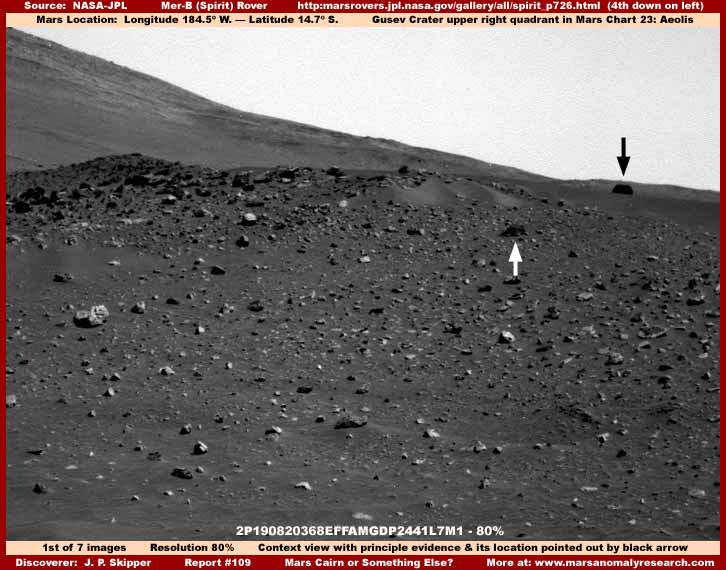
The above first image is one of several in the Spirit rover imaging (others are not shown here) that demonstrate the evidence site as a whole with the primary lone dark bulky evidence object in question in the distant background pointed out by a black arrow. Note how dark the object is. The image is original without any visual enhancements in it by me.
Most of the various images of this lone bulky object show it as a dark mass without any real smaller detail similar to the way it appears above. This particular scene is imaged from the Spirit rover Panoramic camera on Sol 726 and the rover location is elevated just enough in the terrain to see some background behind the object and a little more of the terrain it appears to sit in. I include this scene here to provide general site context wider area terrain information and to demonstrate how alone and what a sharp stand out this object is in this terrain.
The white arrow in the above image also points out a single large rock and its location a bit in the foreground between the camera and the primary evidence object. This rock will be examined near the end of this report and its significance revealed there. For the time being, just note its location in relation to the main evidence object and that it will later be a factor in evidence presented.
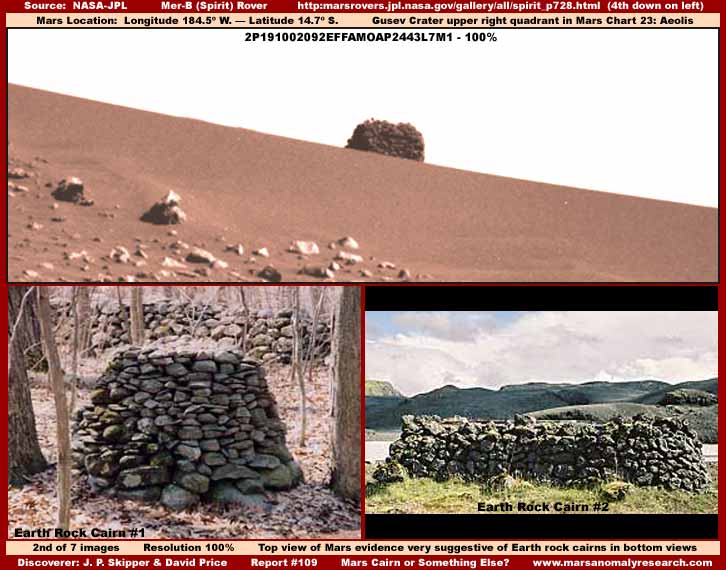
Left Lower Image Source:
http://www.acornbedandbreakfast.com/RockCairns.html
Right Lower Image Source: http://www.hurstwic.org/history/articles/manufacturing/text/land_travel.htm
The above second image and its top closer view demonstrates one of two strips where the object isn't blanked out by too much dark color allowing me to reveal a little more of its detail with a little graphics work. Here it is viewed from the rover camera at a lower elevation causing the object to appear perched sharply right on the terrain horizon line with no lower level background terrain visible behind it. In this still somewhat distant view, we can see some lumpy detail of the object. In fact it appears to look very much like a lone elevated rock or stone cairn very much like the two comparison Earth stone cairns in the bottom two left and right images, especially the one of the left.
This Mars evidence looks pretty convincing as a stone built-up cairn now doesn't it. If it is, this clearly suggests intentional artificial placement of many rocks or stones one upon another by design to achieve this piled up shape and that suggests not only life but intelligent life doing this because there is not even the slightest chance this could occur naturally in nature. Here on Earth, such stone constructed cairns tend to be isolated in their placement in the terrain and you'll note in the first image in this report that indeed this object sits alone in its terrain and stands out completely out of character with that terrain. Here on Earth that is what cairns by design do, draw attention to themselves mostly as location and boundary markers.
If it is that, it certainly drew my attention to it in this imaging quite some time ago and, if it is a marker, it is an effective one. I kept intending to report on it and had partially done so but kept putting finishing it off in favor of other reporting material until recently when viewer David Price in good heads up work on his own brought it back to my attention. I sometimes forget and leave good evidence sitting around here that should be shown. So if you encounter such evidence on your own, like David Price, that I haven't posted yet, including at someone else's website, bring it to my attention because I'm all about quality evidence here.
If this is a artificial constructed cairn as it so appears to be in the above image, note that it also appears to be in very good shape similar to that of the well maintained Earth cairn in the bottom left image. That kind of condition suggest either ongoing maintenance or fairly recent origin at least within the last few hundred years, especially in this environment (as it appears) with wind swept rocks dispersed and scattered everywhere all over the place. The point is that this evidence may be old but its apparent good condition in such an environment not that conducive to its continued well preserved presence tends to deny it being of really ancient origin.
Now obviously a Mars big rock/stone cairn suggests intelligent life in existence on another world. That is a very dramatic possibility but could there be another more natural explanation? Let's take a closer look at this evidence below.
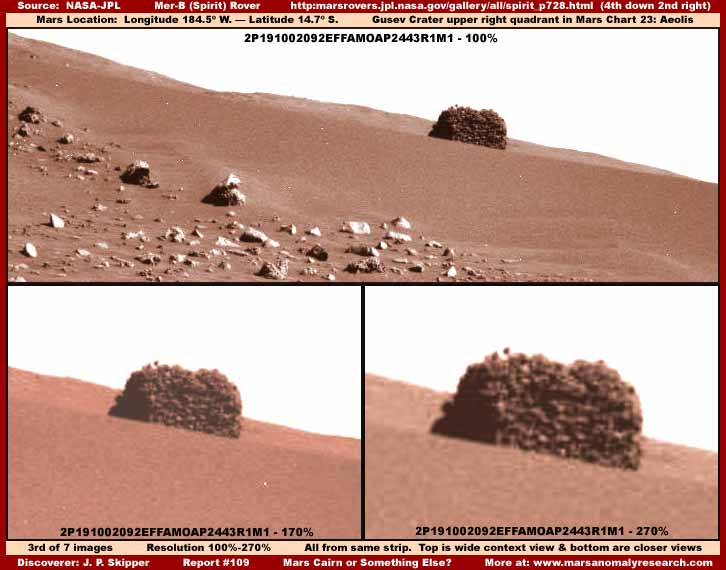
The above third image is of the same evidence object from yet another strip that also allows a rare increasingly closer better look at the object's details in steps. Note that it may still have the general cairn look to a degree, especially in the more distant view, but I'm going to go against that perception and suggest a alternative insight and explanation that I actually have more confidence in that is suggested by the rare ability here to get the closest view of this evidence.
First, let's get one thing out of the way. You see all that sand dune in front of the object? Well I just don't have sufficient confidence that it is real. It's not that this particular dune looks fake (it does) so much as it is the presence of so many other fake sand dunes in the various official images of this general area. In my experience, dunes very often are not real in the rover imaging. I suspect that much of the time they do not hide something anomalous or specific in the terrain but their mostly blank featureless areas save more of the also often fake scattered rock detail having to be thrown into the mix in the total amount of imaging and of course it reinforces the concept that Mars is a dry dead world.
Next, in all raw data shots of this particular object regardless of filters used that can artificially create lighter and darker tones, this evidence is always very dark. Only in a few couple of images is there enough light reflectivity off of the object to determine its many lumpy projections detail and then only with a fair amount of graphics work by me as you see above partially defeating this darkness and revealing more detail.
Now part of that darkness, as compared to the greater reflectivity of the surrounding terrain and many of the rocks in it, is due to general shadow as well as small shadows created by the many lumpy projections of this object. But, this does not explain all of its darkness. This object is dark very much because the object's surface in general absorbs solar light and is more non reflective making it unique in a terrain that generally reflects light.
If it is a cairn, some of this solar light absorption quality may also be explained by the porous pitted quality of the individual rocks used to construct it but again not enough of it can be so explained. I'm going to suggest to you that what we are really looking at here is a very large single rock or boulder of a particular mineral composition completely covered and crowded over by a light absorbing life form, such as for example a low gravity mega size tough lichen that specializes in this rock's mineral composition. I'm suggesting that the rock or boulder geology of this object is not even visible to us because it is hidden under this lichen growth covering.
While this primary object evidence is just a little too distant and obscured by this imaging's poor resolution to completely resolve this issue alone, there is other very suggestive evidence of this suspected lichen scenario, albeit on a smaller scale, in other images of rocks in this terrain site in the immediate vicinity of this large object. In fact, I'm suggesting that what we may be looking at in the imaging evidence above, may be the much larger more mature parent life form from which the other smaller rock growth evidence in this general area is generated from. Along that line of thought, now take a look at the following image evidence.
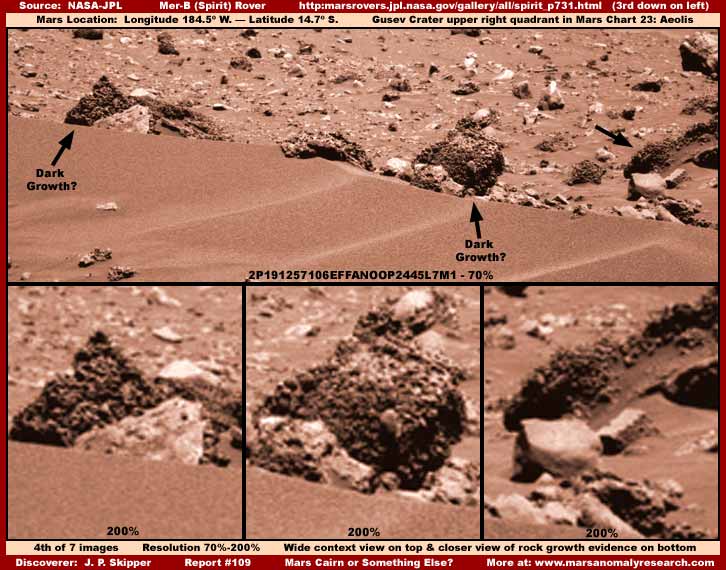
The above fourth image from yet another strip from this same general area demonstrates what I suspect to be a dark very lumpy looking life form growth on smaller rocks existing lower profile in this terrain. Note the very important evidence that portions of the rocks pointed out above are light reflective as bare portions of geological rocks would be expected to be and that other portions of the overall rock surface are covered over by what appears to be rough textured darker more light absorbing material that very probably is the life form it appears to be.
Remember that this evidence is not from Earth but from another world with its own independent evolutionary path, so don't expect the evidence to visually look just like that of something on Earth and especially not in this originally black and white monochrome imaging. In the bottom closer middle image above, note how the dark growth hugs to the rock covering it. However, in the lower closer left image above, note how the dark growth appears to bulk up upon itself in greater depth. Both the lower profile rock hugging and more elevated bulking up visual appearance differences are no doubt part of this life form's normal life cycle depending on rock and other environmental conditions and this is often true of Earth lichen as well.
Now remember that this fourth image evidence is on smaller low profile rocks scattered around in the terrain. If any of the general appearance of this terrain is to be believed, then such smaller lower profile growth sites are precarious at best over the long haul and probably subject to growth inhibiting environment changes like wind and erosion keeping the growth's development on such rocks in periodic check. On the other hand, a huge tall rock of the same special mineral composition such as the "cairn" appearance evidence presented here, would provide a more elevated enduring platform for such growth giving it a better chance to achieve full longer term more mature development and likely acting as a propagating source into the surrounding terrain of its kind.
Now go back up to the previous third image of the large object and note the closer view on the lower right and then compare that with the above fourth image's lower left closer image. It is not hard to imagine the latter smaller rough looking evidence developing on such a larger more stable platform into a even larger much more rough and lumpy looking maturer form as in the third image and I suspect this is the case here. In other words, although the rock cairn and intelligent life scenario may be more dramatic, I suspect that all of the darker light absorbing evidence pointed out here in this report is living natural ecology at work, just a little more unfamiliar looking to the Earth human eye because it exists on a different world with its own unique developmental path and cycles.
We are fortunate that this evidence presented here in this originally black and white fourth image has some semblance of the light and dark tones that facilitates recognizing detail and differentiating differences. I color my images here to give better contrast and bring out better detail. I use the reddish color that tints everything only because that is what so many of us expect to see on the "red" planet Mars but I strongly suspect that this reddish color isn't necessarily this primary everywhere on the planet.
The darker evidence on the rocks is almost certainly a strong solar light absorbing dark color that might even be green contrasting sharply with the bright reflective bare rock geology. However, it should be noted that lichen here on Earth comes in some very strong colors like red, yellow, gray, purple, black, etc. It is likely that the same variations occur on Mars as well.
You should also be aware that perfectly normal filters used in the rover imaging can change the general appearance of certain anomalous evidence like this lichen more than enough to hide its true nature right in plain sight. I suspect it often alone successfully obfuscates anomalous evidence, especially in the closer rover imaging. An example of this appears in the imaging below.
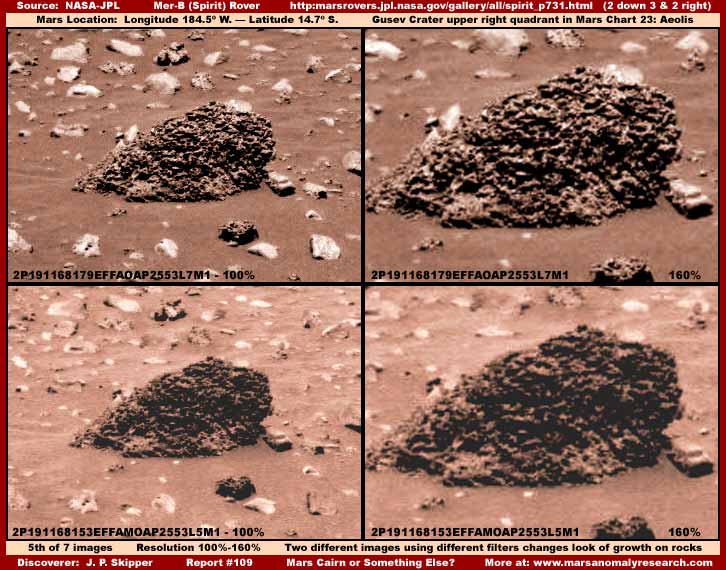
The above fifth image evidence is from two other different strips and of the same rock pointed out with the white arrow in the first first image in this report. According to the official statement, the top imaging was obtain through Spirit rover camera Filter 7 and the bottom imaging obtained with Filter 5. Filters can create light reflectivity and darkness where one or the other would not actually exist creating confusion for the observing Earth human eye. This can be deceiving and serve to obfuscate small scale evidence.
Note in the top two images how the rock surface takes on a lot of harder textured light reflectivity appearance due to light over saturation and in the bottom two images how the rock surface is less so and softer as well as darker. Note how the bottom images tend to visually support the rock life growth scenario and how the same rock in the top images tends to visually support a pitting porous rock surface scenario like for example volcanic rock. This demonstrates what I'm talking about. The success of this obfuscation, whether intentional or not, is further facilitated by the fact that the growth covers just about the entire rock leaving no portion of the more reflective bare rock surface visible for comparison.
On the other hand, note that the rocks in the previous fourth image show parts of the uncovered more light reflective rock geology as differentiated from the more light absorbing darker rougher appearing evidence covering only a portion of the rock. This ability to A-B compare evidence visual differences so closely associated with each other is very informative. The point is that, when a rock is essentially entirely covered by the life evidence with very little of the rock geology showing as in the above fifth image, one type of evidence is much harder to distinguish from the other and the filter obscuring effect becomes much more effective.
This comparison is a demonstration of how filters alone can be used in conjunction with generally poor resolution preventing close examination to effectively create perception confusion and obfuscate life evidence hiding right in plain sight in the rover imaging, just as suspected here. Whether by intent or not, this is good from the secrecy agenda point of view. Why? Because the much more effective automated object specific image tampering often does not recognize rounded and irregularly shaped but quite unacceptable non geometrically shaped objects like skulls, fossils, living ground cover, or lichen covered rocks blending in with and appearing similar to natural geology as candidates for its tampering applications resulting in them escaping same.
This imaging tampering problem sometimes results in something very obvious and anomalous like the big "cairn" looking object here escaping the worst of its administrations. Either way, whether it is ultimately identified as a cairn location marker revealing artificial construction by someone or identified as a boulder harboring more base natural life form evidence, we are talking about life of some kind on Mars with all of the implications of that. Not good from the secrecy point of view.
The fact is that I often see rocks closer in the foreground of the rover imaging with direct object specific smudge applications applied tightly to their surfaces in a plastering effect. This is done because anomalous information in the foreground of the rover imaging is closer to the camera and allows someone like me to blow up and examine the object closer and better even in this incredibly poor heavily .JPEG compressed imaging as compared to mid area and background information. So anomalous information in this foreground area must be dealt with in finer detail than more distantly seen information in the mid and background areas.
Also, it must be remembered that the rover imaging resolution is almost certainly many MANY times finer and closer than as represented by this very poor heavily .JPEG compressed imaging as released to the world. From a tampering point of view, this closer detail works out better in the distant satellite imaging but has some unique problems in the closer rover imaging. Such closer resolutions in the rover imaging of nearby objects results in the software programming literally seeing too much fine detail and becoming a bit overwhelmed by it. Out of the sheer massive detail numbers, the programming is going to see a higher percentage of what appears to it to be geometric detail and so it gets covered whether there is really something anomalous there to cover or not.
Before leaving, I want to draw your attention back to the above fifth image above and specifically to the two right upper and lower closer images. Now look carefully. Do you see anything else additionally suspicious in these images? Okay look at the bright reflective object at the lower right edge of the rock. What do you see? Yes, it's a bonus and I'm not going to charge extra for it. He! He! Now you have to admit that reflective object looks an awful lot like a small toy size vehicle doesn't it.
Is this a parked means of transportation for little Martian being living under this rock? Did some Martian kid drop his Earth vehicle toy in the Mars Gusev Crater wastes on a fly over? Did some American kid drop and forget his toy in a Earth south western dessert scene where some of this terrain detail may have come from? How about some Mongolian kid dropping his Chinese toy in the dessert there where this scene may have come from? Or is it just a rock coincidentally eroded into this shape?
Who knows but I thought you would at least want a chance to check it out. Tiny size very suspicious but blurry looking suggestive anomalous evidence like this is plentiful in the rover imaging because of the sheer countless numbers of objects and detail. However, unless it can rise above a merely suggestive level or can be included with better evidence as here, I normally don't report on it.
THE LICHEN/FUNGI CONNECTION?
Now the rock lichen/fungi/plant interpretation scenario that I present here may catch some of you off guard a bit and some may be wondering where I'm coming from on this. No I didn't pull this concept out of the thin air for the lack of a better explanation as the "cairn" explanation would have alone demonstrated the life on Mars concept. Rather this lichen interpretation is based on my accumulative experience observing many thousands of Mars satellite images and seeing many different types of lichen/fungi growth in them. Some I've reported on and some will be forthcoming in future reports.
Now it needs to be understood in a short explanation that Lichens are not a single life form but are symbiotic associations of fungus with a photosynthetic partner like algae that can produce food from sunlight quite nicely. On Earth lichen comes in great variety with some the size of bacterium to larger object hugging lumps to many long strands of filaments to even larger forms mimicking the look of smaller and larger bulky plants.
One should should also not underestimate the hardy toughness and persistence of lichen growth either. A ESA 2005 experiment demonstrated that lichens can survive prolonged open exposure to the vacuum of space apparently going dormant there but returning to normal life activity upon return to Earth. Read about this at the link below.
http://www.newscientistspace.com/article/dn8297
The point I'm making here is that lichen growth in general is obviously not put off much by very harsh tough environmental conditions in case you might be inclined to think that conditions on Mars would be too tough for their survival. In general, never underestimate life and its tenacity to survive.
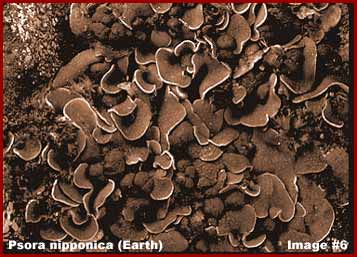
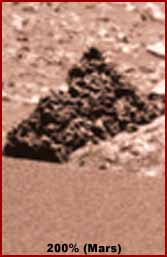
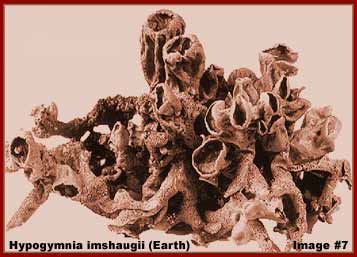
Left Image: http://www.lichen.com/bigpix/Pnipponica.html
Right Image: http://waynesword.palomar.edu/p1jan98.htm
The evidence presented here in this report of probable growth on Mars rock geology big and small appears to indicate the bulky plant looking type of lichen growth perhaps similar to the above left and right example images of lichen growth here on Earth. The blurry center Mars image from the previous fourth image is thrown in between them and repeated here for visual comparison.
Now these left and right Earth based lichen examples above clearly do not replicate the blurry center Mars growth exactly nor would one expect this to be probable since these samples come from different worlds and Mars obviously has substantially different environmental conditions and without a doubt cycles and paths of life development. But I think you can probably see basic visual similarities. Note the very tight density of the growth and its thick, bulky, elevated, lumpy visual similarities. All of this is typical of lichen growth in general and the plant looking growth lichen type in particular.
Now lichen growth here on Earth is for the most part much smaller in physical size than on Mars. This may be an adaptation to Earth's much higher gravity well, higher atmospheric moisture content, and higher oxygen content? On Mars giantism size scale appears to often be the name of the lichen game as per other lichen/fungi growth that I will be examining in later reporting. This is likely due in large part to the lower gravity well of Mars in comparison to Earth and/or higher CO2 atmospheric content. Also, it is also no doubt due to the fact that only grossly large objects can be reasonably seen in the distant poor quality satellite imaging and normal size detail for the most part can't be seen at all.
The bottom line is that the evidence presented here in the fourth evidence image conclusively demonstrates that the darker more light absorbing irregular lumpy material is something attached to, likely growing on, and separate from the upper surface of the underlying more light reflective rock geology. We are very fortunate that both the covering material and the inanimate rock geology base material it exists on can reasonably clearly be distinguished from each other allowing more definitive identification of each. This is unlike the evidence in the smaller fifth image rock and the much larger second and especially third images where the living material has engulfed the underlying base rock geology hiding it from view and making identification more difficult.
This brings us back full circle to the primary very large object and what we may be seeing there. It could be a rock cairn but I doubt it. I strongly suspect that we are looking at a very large rock or boulder completely covered by living organisms that are most likely the plant looking type lichen growth that has grown to much larger proportions there due to this larger taller base object being a more elevated stable longer term platform for the lichen growth in a rather tough environment. I also suspect it may even be the parental life form for surrounding smaller size less mature lichen growth struggling to flourish on nearby smaller less hospitable rocks and even tougher conditions as represented by the fourth and fifth images evidence.
There is also a last point to consider. In the now long life and travels of either rover, there is no evidence like that of the big lone "cairn" looking object, at least in any of the released data. In other words, according to the data record that has been released to us, this object is very much unique. So you have to ask yourself a few questions.
Do you think for a moment that a team of scientists here on Earth guiding the Spirit rover would see such a highly conspicuous big lone unique lumpy object standing out so sharply alone in the distant terrain and not direct the rover over to it for closer examination, imaging, and possible testing? Can you really see them failing to do that? Can you see yourself or anyone you know not doing that and just ignoring this suspicious looking anomalous object on another world? Can you really believe that? I know I can't! It just isn't conceivable by any rational inquisitive person must less scientist exploring another world!
I think that it is nearly impossible that this didn't happen. I think this object was examined and all that closer better examination information was culled from the record except for this distant remote material we've been looking at here. Alternatively, if it truly wasn't examined, it could only be because the rover operators already knew from roving experience what they were looking at from a distance and it represented nothing new and of interest to them. What does that say about the evidential material that very likely isn't being released to us? Any other explanation is completely illogical.
As a similar example, some of you may remember my 2004 Report #072 titled "Opportunity Mixed Evidence." In that report is a very clear artificially work old thick discarded timber laying on the ground. The rover tracks pass right over and across this object and the evidence record released to us does not reveal that any closer imaging or testing was made of it. Look at it for yourself at the above link. Can you accept that no examination of such an anomalous appearing artificially worked looking object was made? It doesn't get any more incredible or more obvious than that. Remember, what you don't see is evidence to. The lack of evidence speaks just as strongly as to credibility or lack of same. Further, if you note some of the manipulated terrain images also in that particular older report, you'll never be liberal with your trust of official imaging again.
In any case, one way or the other, we once again have some strong evidence of life of some kind on Mars here to add to that previously posted at this website. As such evidence and its variety accumulates more and more here, the pendulum also swings more and more away from blind trust to cautious independent thought for many. That's a good thing because too much blind trust equates to too much to abdication of responsibility and being disengaged. That's not a good thing. What is coming requires that as many of us as possible will need to be engaged and have this subject matter thoroughly on our radar.
DOCUMENTATION
http://marsrovers.jpl.nasa.gov/gallery/all/2/p/726/2P190820368EFFAMGDP2441L7M1.HTML: This link takes you to the official JPL Sol 726 Panoramic raw science data image that my first image evidence in this report was sourced from providing a wide-angle context view of the general evidence site.
http://marsrovers.jpl.nasa.gov/gallery/all/2/p/728/2P191002092EFFAMOAP2443L7M1.HTML: This link takes you to the official JPL Sol 728 Panoramic raw science data image that my second top image evidence in this report was sourced from demonstrating the rock "cairn" look in comparison to rock cairns here on Earth in the bottom images.
http://marsrovers.jpl.nasa.gov/gallery/all/2/p/728/2P191002092EFFAMOAP2443R1M1.HTML: This link takes you to the official JPL Sol 728 Panoramic raw science data image that my third image evidence in this report was sourced from demonstrating progressively closer views of the primary large rock cairn looking evidence.
http://marsrovers.jpl.nasa.gov/gallery/all/2/p/731/2P191257106EFFAN00P2445L7M1.HTML: This link takes you to the official JPL Sol 731 Panoramic raw science data image that my fourth image evidence in this report was sourced from demonstrating a wide-angle context view on top and below that closer views of various light reflective rocks with darker lichen growing on them.
http://marsrovers.jpl.nasa.gov/gallery/all/2/p/730/2P191168179EFFAMOAP2553L7M1.HTML: This link takes you to the official JPL Sol 730 Panoramic raw science data image that my fifth image top light over saturated evidence in this report was sourced from demonstrating two different views of the same large rock showing the different impact on the look of lichen evidence on this rock via the use of camera filters.
http://marsrovers.jpl.nasa.gov/gallery/all/2/p/730/2P191168153EFFAMOAP2553L5M1.HTML: This link takes you to the official JPL Sol 730 Panoramic raw science data image that my fifth image bottom darker material evidence in this report was sourced from demonstrating two different views of the same large rock showing the different impaact on the look of lichen evidence on this rock via the use of camera filters.
, Investigator
![]()